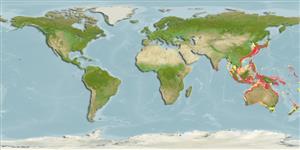Environment: milieu / climate zone / depth range / distribution range
Ecología
marino demersal. Tropical
Distribución
Países | Áreas FAO | Ecosistemas | Ocurrencias, apariciones | Point map | Introducciones | Faunafri
Western Pacific: southern Japan, southern Indonesia, and northwestern Australia (Ref. 5978). Reported from Taiwan (Ref. 5193).
Tamaño / Peso / Age
Maturity: Lm ? range ? - ? cm
Max length : 8.5 cm SL macho / no sexado; (Ref. 9824)
Espinas dorsales (total) : 0; Radios blandos dorsales (total) : 81 - 93; Espinas anales: 0; Radios blandos anales: 62 - 71. This species differs from other members of the genus by having dark spots along the upper and lower edges of its body, extending to basal part of the dorsal and anal fins, posterior part of the caudal fin and a dark band, upper limb of gill arch with gill rakers. This genus is characterized by having eyes separated by a bony ridge of very narrow space anteriorly and a ridge posteriorly, a small mouth about equal to eye diameter, ctenoid scales on ocular side armed with a row of hairlike spines.
Inhabits sand and mud bottoms (Ref. 9824). Feeds on small polychaetes, crustaceans, and fishes (Ref. 9824). Caught mainly with bottom shrimp trawls (Ref. 9824).
Life cycle and mating behavior
Maturities | Reproducción | Spawnings | Egg(s) | Fecundities | Larva
Masuda, H., K. Amaoka, C. Araga, T. Uyeno and T. Yoshino, 1984. The fishes of the Japanese Archipelago. Vol. 1. Tokai University Press, Tokyo, Japan. 437 p. (text). (Ref. 559)
IUCN Red List Status (Ref. 130435)
Threat to humans
Harmless
Human uses
Pesquerías: sin interés
Herramientas
Special reports
Download XML
Fuentes de Internet
Estimates based on models
Preferred temperature (Ref.
123201): 16.7 - 27.9, mean 24.9 °C (based on 446 cells).
Phylogenetic diversity index (Ref.
82804): PD
50 = 0.5010 [Uniqueness, from 0.5 = low to 2.0 = high].
Bayesian length-weight: a=0.00912 (0.00408 - 0.02036), b=3.05 (2.87 - 3.23), in cm total length, based on LWR estimates for this (Sub)family-body shape (Ref.
93245).
Nivel trófico (Ref.
69278): 3.7 ±0.53 se; based on food items.
Resiliencia (Ref.
120179): Alto, población duplicada en un tiempo mínimo inferior a 15 meses (Preliminary K or Fecundity.).
Fishing Vulnerability (Ref.
59153): Low vulnerability (10 of 100).
